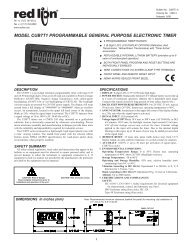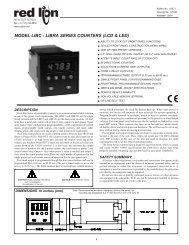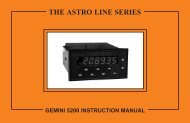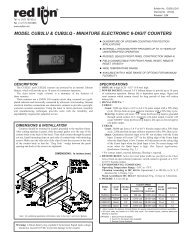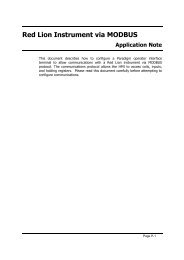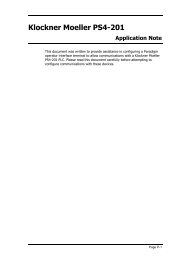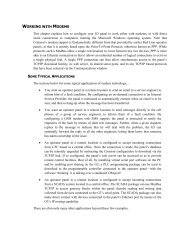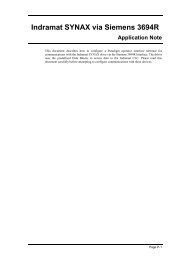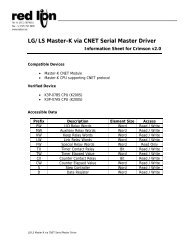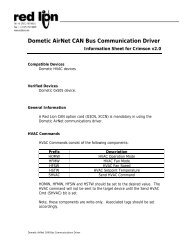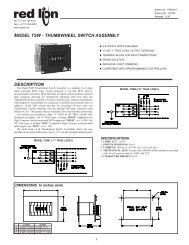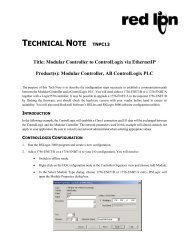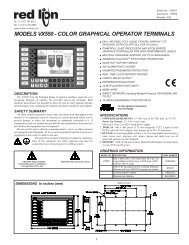PAXI PAXC PAXR Data Sheet/Manual PDF - Red Lion Controls
PAXI PAXC PAXR Data Sheet/Manual PDF - Red Lion Controls
PAXI PAXC PAXR Data Sheet/Manual PDF - Red Lion Controls
Create successful ePaper yourself
Turn your PDF publications into a flip-book with our unique Google optimized e-Paper software.
6.0 PROGRAMMING THE METER<br />
Shaded areas represent program access that is model dependent.<br />
PROGRAMMING MODE ENTRY (PAR KEY)<br />
The meter normally operates in the Display Mode. No parameters can be<br />
programmed in this mode. The Programming Mode is entered by pressing the<br />
PAR key. If it is not accessible then it is locked by either a security code, or a<br />
hardware lock.<br />
Two types of programming modes are available. Quick Programming Mode<br />
permits only certain parameters to be viewed and/or modified. All meter<br />
functions continue to operate except the front panel keys change to Programming<br />
Mode Operations. Quick Programming Mode is configured in Module 3. Full<br />
Programming Mode permits all parameters to be viewed and modified. In this<br />
mode, incoming counts may not be recognized correctly, the front panel keys<br />
change to Programming Mode Operations and certain user input functions are<br />
disabled. Throughout this document, Programming Mode (without Quick in<br />
front) always refers to “Full” Programming.<br />
MODULE ENTRY (ARROW & PAR KEYS)<br />
The Programming Menu is organized into nine modules. These modules group<br />
together parameters that are related in function. The display will alternate between<br />
��� and the present module. The arrow keys (F1� and F2�) are used to select<br />
the desired module. The displayed module is entered by pressing the PAR key.<br />
MODULE MENU (PAR KEY)<br />
Each module has a separate module menu (which is shown at the start of each<br />
module discussion). The PAR key is pressed to advance to a particular parameter<br />
to be changed, without changing the programming of preceding parameters.<br />
After completing a module, the display will return to ������. Programming may<br />
continue by accessing additional modules.<br />
SELECTION / VALUE ENTRY (ARROW & PAR KEYS)<br />
For each parameter, the display alternates between the present parameter and<br />
the selections/value for that parameter. The arrow keys (F1� and F2�) are used<br />
to move through the selections/values for that parameter. Pressing the PAR key,<br />
stores and activates the displayed selection/value. This also advances the meter<br />
to the next parameter.<br />
For numeric values, the RST key may be used to select a specific digit to be<br />
changed. Once a digit is selected, the arrow keys are used to increment or<br />
decrement that digit to the desired number.<br />
x = Counter A or Counter B<br />
OVERVIEW<br />
PROGRAMMING MENU<br />
PARAMETER MENU<br />
12<br />
PROGRAMMING MODE EXIT (DSP KEY or at ������ PAR KEY)<br />
The Programming Mode is exited by pressing the DSP key (from anywhere<br />
in the Programming Mode) or the PAR key (with ������ displayed). This will<br />
commit any stored parameter changes to memory and return the meter to the<br />
Display Mode. If a parameter was just changed, the PAR key should be pressed<br />
to store the change before pressing the DSP key. (If power loss occurs before<br />
returning to the Display Mode, verify recent parameter changes.)<br />
PROGRAMMING TIPS<br />
It is recommended to start with Module 1 for counting and Module 4 for rate.<br />
If lost or confused while programming, press the DSP key and start over. When<br />
programming is complete, it is recommended to record the parameter<br />
programming on the Parameter User Chart and lock out parameter programming<br />
with a user input or lock-out code.<br />
FACTORY SETTINGS<br />
Factory Settings may be completely restored in Module 9. This is a good<br />
starting point for programming problems. Most parameters can be left at their<br />
Factory Settings without affecting basic start-up. These parameters are<br />
identified throughout the module explanations.<br />
ALTERNATING SELECTION DISPLAY<br />
In the explanation of the modules, the following dual display with arrows will<br />
appear. This is used to illustrate the display alternating between the parameter<br />
on top and the parameter’s Factory Setting on the bottom. In most cases,<br />
selections and values for the parameter will be listed on the right.<br />
Indicates Program Mode Alternating Display<br />
Parameter<br />
�����<br />
�<br />
�<br />
���<br />
Factory Settings are shown.<br />
Selection/Value<br />
6.1 MODULE 1 - COUNT A & B INPUT PARAMETERS (�����)<br />
<strong>PAXC</strong> & I<br />
Module 1 is the programming for Counter A, Counter B and the Prescaler Output. Counter B parameters follow the Prescaler parameters. For<br />
maximum input frequency, the counters should be set to mode NONE and the Prescaler to NO when they are not in use. When set to NONE<br />
or NO, the remaining related parameters are not accessible. A corresponding annunciator indicates the counter being shown in the Display<br />
Mode. An Exchange Parameter Lists feature for scale factors and count load values is explained in Module 2.



